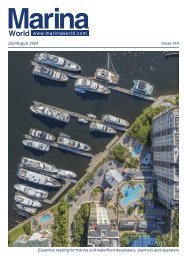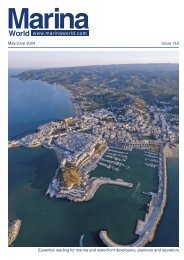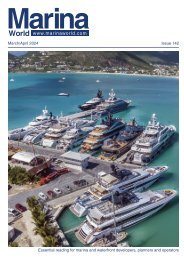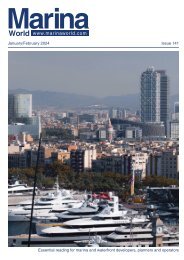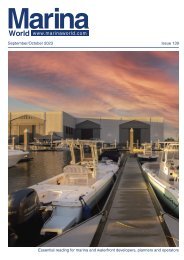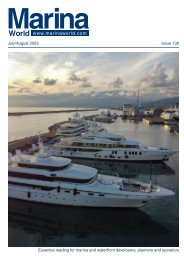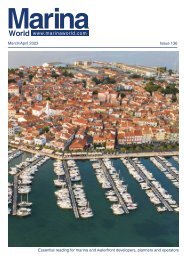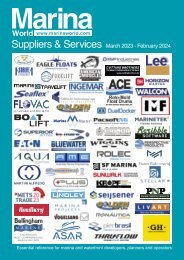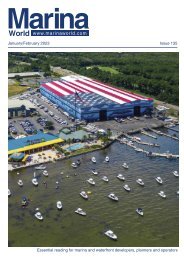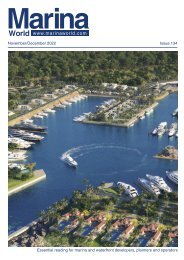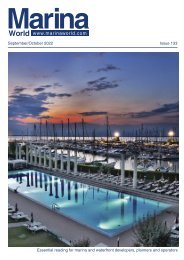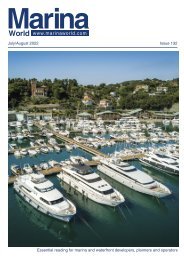2023 May June Marina World
The magazine for the marina industry
The magazine for the marina industry
Create successful ePaper yourself
Turn your PDF publications into a flip-book with our unique Google optimized e-Paper software.
DRYSTACK STORAGE<br />
Notables elsewhere in<br />
Italy include <strong>Marina</strong> Santa<br />
Marinella’s Porto Castello, a<br />
dry port for sailing boats in<br />
the province of Rome, and<br />
Deiva <strong>Marina</strong> Service, the<br />
only drystack in Liguria. Deiva<br />
caters for boats up to 10m<br />
(33ft) and uses a hydraulic lift<br />
platform, electric forklifts and<br />
trolleys. It is active from <strong>June</strong> to<br />
September and then winterises<br />
boats. It has no wet berths.<br />
Dry ports for France<br />
There are several dry ports<br />
but very few true drystacks<br />
in southern France. They<br />
strive to offer the ambience<br />
of a wet marina. Jean Michel<br />
Gaigné, representative of the French<br />
and TransEurope marina industry<br />
associations, cites the best examples<br />
as Port Inland at Mandelieu La<br />
Napoule, Portland at Hyères and Port<br />
Navy Service at Port Saint Louis du<br />
Rhône.<br />
Other<br />
examples<br />
are mostly<br />
in open<br />
areas where<br />
something<br />
akin to<br />
drystack is<br />
Pascal Jourdan, Portland. offered in the<br />
summer. They are close to maintenance<br />
and refit facilities, and space for<br />
wintering within first class marinas.<br />
How do they differ from drystacks<br />
in the UK and northern Europe? “We<br />
started up in 1989 and we represent<br />
the first European dry port,” says Erika<br />
Drouard, director of Port Inland, which<br />
has 800 berths for motor boats up to<br />
Port Inland at Mandelieu La Napoule in France is seen as the first<br />
European dry port and has 800 dry berths.<br />
11m (36ft) and 5 tonnes. She believes<br />
they have an edge because customers<br />
can access their boats seven days a<br />
week year round (except Christmas<br />
and New Year) and have access to<br />
maintenance, free parking, speciality<br />
shops, a bar, restaurant and a huge<br />
range of on-site industry professionals.<br />
Customer trends show increased<br />
storage demand for boats of 9m (29ft<br />
6in) and above and recent frustrations<br />
lie in the regional drought. “The inability<br />
to wash their boats has annoyed<br />
customers a lot,” she admits, “so much<br />
so that some have even given up using<br />
theirs.”<br />
Further south, on the bay of Hyères,<br />
Portland offers 500 dry berths and 50<br />
wet berths and has been in operation<br />
for 25 years. Pascal Jourdan, manager<br />
of both dry and wet port, explains<br />
the dry operation: “We have no roof<br />
or sides for 75% of the racking. We<br />
do not use apps. The staff record<br />
customer requests via telephone<br />
or when they arrive.” Customers<br />
appreciate the reduced<br />
boat maintenance,<br />
excellent security,<br />
comfortable waiting area,<br />
the successful ‘parking<br />
formula’ (various fees<br />
for different usage),<br />
management of boat<br />
shares and summer<br />
aperitifs.<br />
Customer practices and<br />
demands have changed in<br />
recent years. “Boaters go<br />
out less, but for the whole<br />
day – from 10.00am to<br />
Portland is a busy drystack<br />
on the French bay of Hyères<br />
with racks for 500 boats and<br />
50 wet berths.<br />
7.30pm – to make the most of<br />
the opportunity. What hasn’t<br />
changed is the strong demand<br />
in August,” she says, and notes<br />
the new demands as being<br />
for categories the marina<br />
cannot cater for – like sailboats<br />
and catamarans. “There are<br />
currently about 130 ongoing<br />
requests for space and, when<br />
offered at reasonable prices,<br />
most customers also want<br />
follow-up maintenance. All<br />
appreciate the turnkey readyto-sail<br />
option.”<br />
Jourdan believes the<br />
scarcity of drystacks in the<br />
Mediterranean is less about<br />
demand than feasibility.<br />
“You need to have a lot of land for<br />
car parking. On a rotational basis on<br />
average you have to calculate two cars<br />
per boat.”<br />
While Portland is forced to turn away<br />
catamarans, Port Navy Service in Port<br />
Erika Drouard, Port Inland.<br />
Saint Louis du Rhône is a very different<br />
story. Nicknamed Cataland, it hosts sail<br />
and motor boats up to 120 tonnes for<br />
maintenance and mooring on a 22ha<br />
(54.4 acre) site, which includes large<br />
hangars and extensive outdoor space.<br />
Considered the largest dry port in<br />
Europe, it is also popular for winterising.<br />
But although it guarantees fast delivery<br />
and short waiting times, it is far more<br />
a fantastic dry port than a traditional<br />
drystack and in 2010 enriched its<br />
offering by opening an elegant yacht<br />
club for its members.<br />
Plan first in Catalonia<br />
Although detailed information is harder<br />
to come by, Spain suffers a similar<br />
dearth of drystacks. Javier Garcia<br />
Camps, manager of the Yacht Harbour<br />
Association in Catalonia (ACEPT)<br />
says there are only three in Catalonia:<br />
<strong>Marina</strong> Vela Barcelona; <strong>Marina</strong><br />
Badalona; and Port Forum.<br />
Why only three? “The reason is very<br />
simple for Catalonia,” he says. “When<br />
a group, a company or a private entity<br />
38 www.marinaworld.com – <strong>May</strong>/<strong>June</strong> <strong>2023</strong>



